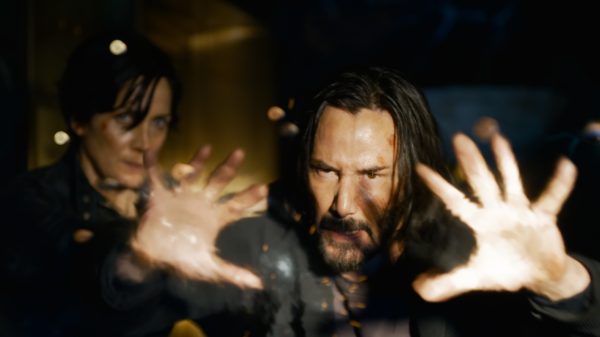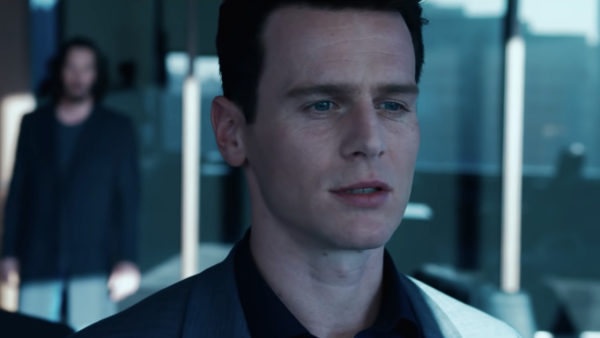As far as remakes/reboots/sequels go, Lana Wachowski’s The Matrix Resurrections is completely unique.
While fans of action spectacle will lament that the set pieces are not on par as the lobby scene from the original or the car chase from Reloaded, the new film works amazingly well in three unique ways. The Matrix Resurrections is:
- A big budget blockbuster that actively critiques franchises, as well as its parent company, Warner Brothers
- A LGBT text that positions queers behind and in-front of the camera
- A love story masquerading as an action film

1) The premise of Resurrections is as follows: The Matrix trilogy was not real, but rather a revolutionary video game developed by Thomas Anderson (Keanu Reeves). He has toiled away for the past twenty years as the creative mind in a commercial partnership with Jonathan Groff’s character.
At the beginning of the film, the pair are ordered by their parent company, Warner Brothers, to make a fourth entry in the franchise because The Matrix is valuable IP that has been sitting dormant for too long. So even though Anderson never planned to make another entry, he’s now being forced to return to the franchise that made him famous.
Of course, there’s far more to the story than that. The reclusive genius still regularly sees Tiffany (Carrie-Anne Moss), the married mother of three who inspired the character of Trinity, at a local coffee shop. And Anderson can’t help but tinker with his original game code, leaving open a game loop where new character Bugs (Jessica Henwick) discovers Morpheus (now played by Yahya Abdul-Mateen II).
For audiences, there is little question that Neo is the real character and Anderson’s life is the simulation (the film literally opens with a sequence that confirms The Matrix has returned in a different form). This hardly matters, though because the film is doing something particularly fascinating early on. Resurrections spends most of its first act critiquing how The Matrix’s pop psychology ideas have been distilled and appropriated for capitalistic purposes; namely spoon-feeding the franchise to the brainwashed masses.
It’s a brazen and confronting message for a big budget holiday blockbuster and one that Wachowski, along with co-writers David Mitchell and Aleksandar Hemon, make no effort to hide or even address subtly. This argument is loudly and repeatedly raised, admittedly in a humourous, very self-aware way, but it’s totally fascinating to witness.

2) Another revolutionary aspect of the film is just how damn queer it is. The original trilogy never lacked for LGBT – and more specifically trans – readings, particularly after Lana and her sister Lilly transitioned. The new film, however, is so unabashedly queer to that it occasionally feels tailored to the LGBT community.
In addition to Lana behind the camera, the film is heavily populated by queer creatives. There’s Groff as Neo’s adversary, as well as Neil Patrick Harris as his therapist, who is attempting to keep him grounded in the “real world”. There’s also Brian J Smith as Berg, and Lambert Wilson reprising his role as the Merovingian. Joining them are queer favourites/icons Moss, Jada Pinkett Smith, Priyanka Chopra Jonas, Christina Ricci and Smith’s Sense8 co-star Max Riemelt.
It’s worth noting that Gross, who plays a familiar character, leans into the homoeroticism that was present in the original trilogy in a way that feels very knowing. By casting Groff and nurturing this performance, which is less adversarial and more about his admiration and even affection for Neo, the new film appears to acknowledge that what was previously subtext is, in fact, canonically queer.
All in all, it’s just a very LGBT (friendly) blockbuster. And that’s before the film’s location (San Francisco), its kink/queer costume design and its favourite word – binary* – are even considered.
*Seriously: if there’s a drinking game to be played with the film, it is how frequently “binary” is said. It will undoubtedly prompt plenty of Googling for non-queer audiences, which is incredibly clever, understated activism on Wachowski’s part.

3) The final exciting aspect of Resurrections is how unconcerned it is with playing within the traditional confines of the action genre. While there are certainly the expected set-pieces, including an extended car chase and helicopter/rooftop sequence in the climax, the film’s foundation is the love story between Neo and Trinity.
It’s a wise decision that pays off because Resurrection is actively playing on audience nostalgia for these characters and the films. While at times the use of archival footage of the OG trilogy undermines the current project by reinforcing elements that are absent or less effective in the new film, these scenes also implicitly acknowledge that the audience is returning for this fourth film because we missed this world, and more specifically Neo and Trinity.
By centering the narrative around their (delayed re)union, Resurrection is playing to its strengths: the actors are as great as ever, they look amazing, and their chemistry has somehow only gotten better with time. We yearn for the pair to come back together, and as such, even the bumpy aspects of Resurrections are smoothed over in pursuit of that objective.
It’s not wholly successful, particularly the impact of the fight choreography and occasionally its editing. The train sequence, in particularly, feels very choppy and even difficult to follow at times, while the fight with the Merovingian’s exiles is uninspired and too long. But these are minor complaints when the film is doing so many other things well.
Overall: The Matrix Resurrections is big, brash and unabashedly queer and romantic. When it is commenting on itself or focusing on Neo and Trinity, it feels like no time has passed. In a world that too frequently prioritizes soulless IP, this extremely personal and surprisingly intimate franchise blockbuster is an incredibly welcome change of pace.
The Matrix Resurrections is now playing in theatres and HBO Max.
It was boring